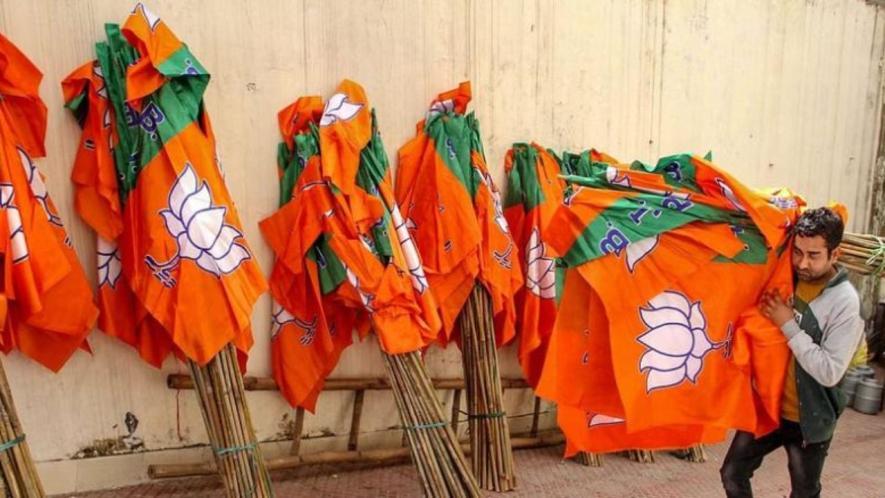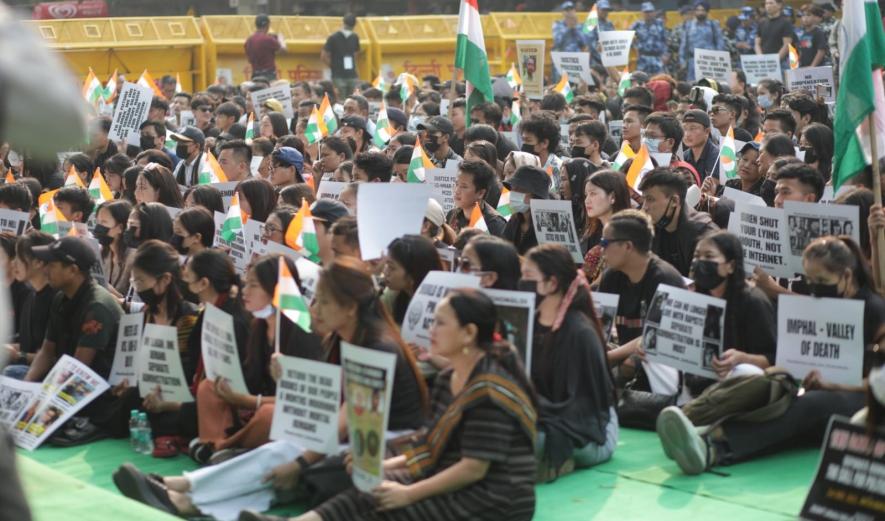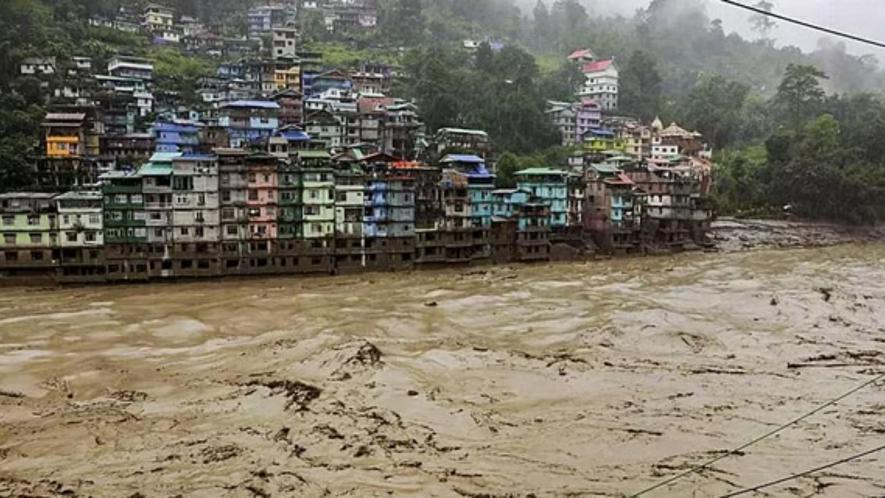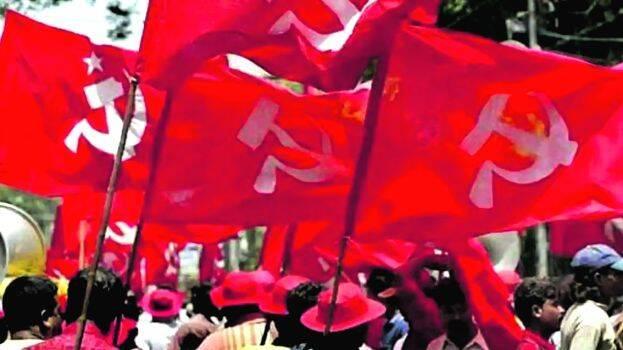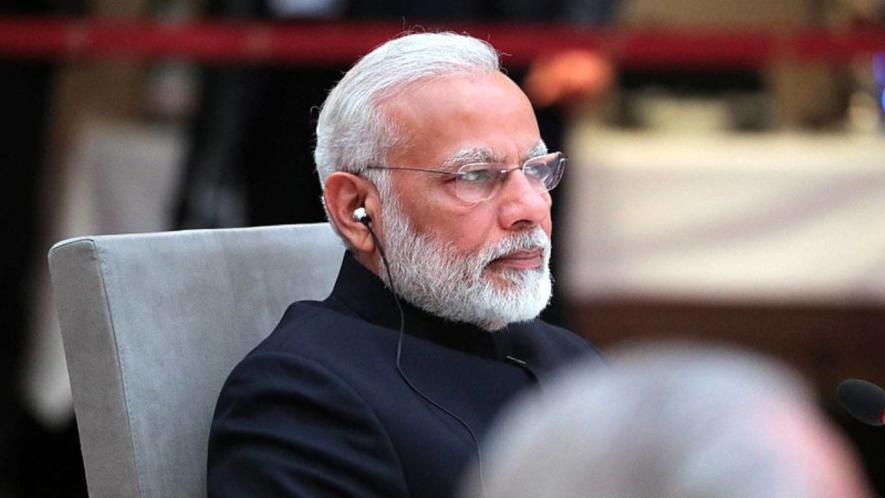The Modi Years: Dismantling Democracy, Brick by Brick
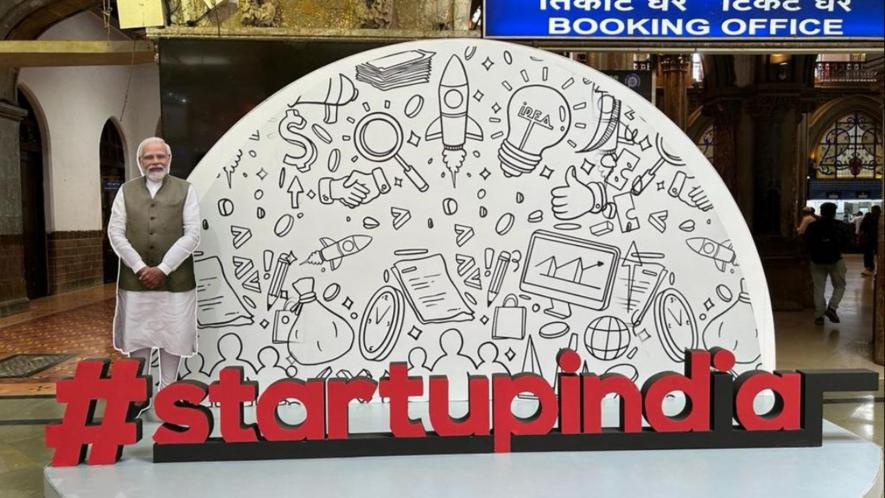
A selfie point featuring Prime Minister Narendra Modi installed at Chhatrapati Shivaji Maharaj Terminus railway station in Mumbai in August. Image Courtesy: Twitter/ @Central_Railway
P Raman |
Let’s begin with Parliament, which is the foundation of what Narendra Modi describes as the ‘Mother of Democracy.’ During the G20 Summit in India, a booklet was published and an exhibition was held on the virtues of democracy.
The visuals of Modi kneeling at Parliament’s doorstep when he first entered the building as Prime Minister in May 2014 are still fresh. He broke down and was in tears.
Then, during his second tenure, Parliament was shifted to a new magnificent building, which the Prime Minister — not the President who, along with the two Houses constitute Parliament — inaugurated in September last year with great pomp and show.
All such song and drama was to conceal a harsh truth: the Modi regime’s consistent attempts to devalue Parliament as the powerhouse of a vibrant democracy.
The Prime Minister’s Office answered just 13 questions in Parliament till 2022, as compared to Manmohan Singh’s 85 questions during the 10 years of the United Progressive Alliance government.
Let’s look into how during the Modi decades, Parliament lost its role as a forum of deliberative democracy.
- As per PRS Research, the 17th Lok Sabha was the shortest since 1952. Of the Lok Sabhas that completed full term, the 16th House (also under Modi) had just 331 sittings, the lowest number.
- Modi’s 17th Lok Sabha had the lowest number of Bills subjected to committee scrutiny — 37 of 210 Bills or 17.6 %. It was 25% during the 16th Lok Sabha. No Bill was referred to committees during the last Winter session of Parliament. The figures for the previous Manmohan Singh decade were 60% and 70%, respectively. This sharp decline shows the present regime’s disdain for scrutiny.
- Similarly, there was a big fall in the number of short duration discussions during the 17th Lok Sabha. Such discussions allow members to express their views.
- The 17th Lok Sabha was without a Deputy Speaker throughout its tenure.
- For the first time, Parliament under Modi witnessed a record number of arbitrary suspensions — almost 20 % of the Lok Sabha during the Winter session.
- The PM himself was present in the Lok Sabha for just four hours during 2021.
All his predecessors, including Atal Bihari Vajpayee, made it a point to be present during all important days, often taking notes and intervening in debates.
Independent India has never gone into general elections with so many Opposition state ministers, including a Chief Minister, political workers and social activists, humanitarian workers and media persons languishing as undertrial prisoners. Many were in jail for over eight years. Octogenarian Father Stan Swamy died in prison, while it was Supreme Court that freed an ailing Varavara Rao (in the Bhima Koregaon case). Activist Gautam Navlakha’s term in the same case was reduced to house arrest on court orders.
Former JNU scholar Umar Khalid, for instance, has had 14 adjournments in SC, and was forced to withdraw his bail petition from the top court and go back to the trial court.
Former Jharkhand Chief Minister Hemant Soran is in jail. The Enforcement Directorate is gunning for another CM, Arvind Kejriwal, who has also been put in jail. The Modi regime has put several senior opposition state ministers in jail in different states on charges filed by ED/CBI.
Like a true elected authoritarian, the incumbent PM has changed the whole ecosystem of governance, brick by brick, grabbing for himself the control of all levers of administration.
Let’s look at what happened during his 10-year rule:
- No PM in India has himself laid so many foundation stones and inaugurated so many projects as Modi: Each of the 82 Vande Bharat trains, many physically and some virtually, Na Mo Bharat trains,, every Central project in states, including defence, even the ordinary launches. He himself announced the names of India’s astronauts and stole the limelight.
- No regime in the past has arm-twisted the judiciary so brazenly. Barely three months after coming to power, Modi tried to snatch the power of appointments and transfer of judges to himself by passing the National Judicial Appointments and Transfers Bill in August, 2014. But the Supreme Court struck it down and restored the collegium system.
- The Modi regime tried to frustrate the collegium system by resorting to a ‘pick and choose’ approach to notifying the names recommended by the collegium. At times, around 50 names recommended by the collegium were pending with the government. The Supreme Court had to come down hard.
The government even tried to manipulate the roster system allegedly to tweak verdicts in its favour.
- India has never witnessed so many public interest litigations in Supreme Court and High Courts — a clear symptom of the excesses or inaction by the Modi government. Aggrieved citizens are left with no way but to knock at the judiciary’s door. Every other day, the Supreme Court and high courts intervene, sometimes favourably, and often justifying the government.
- Another first for Modi was his attempt at politicisation of the armed forces. Last year’s Combined Commanders’ Conference was held not at military station but at the Kushabhau Thakre Centre, with the Bharatiya Janata Party (BJP) idol Sardar Vallabhbhai Patel as the backdrop. Next to the gate of the venue was a big picture of Modi flanked by Rajnath Singh (Defence Minister) and the then Madhya Pradesh CM Shivraj Singh Chouhan.
- Last year, 822 Modi selfie points were put up at different points in military establishments. This was on orders by the Defence Ministry. This had never happened in the past.
- We have already dealt with systematic cult creation by setting up Modi colleges, schools, NaMo lotus, NaMo trains, temples, Modi chalisa and naming welfare schemes after him. A Modi critic-turned cheer leader has also mooted establishing Modi study centres in every district in India. Now someone in Maharashtra, hold your breath, is working on a ‘Modi script.’
- If encounter killing is an old practice, bulldozer justice, bulk closure of madrasas and attacks on Muslim establishments are Uttar Pradesh Chief Minister Yogi Adityanath’s innovation to target minorities. Other BJP-ruled states, like Madhya Pradesh, are also vigorously adopting these methods. The latest entrant in this “extra-judicial punishment” is cancellation of passports and visas of supporters of the protesting farmers.
- Modi’s other record relates to the harassment of political rivals and minorities. The Lok Sabha was told that 8,947 people were arrested, 701 cases of sedition were registered under the anti-terror UAPA (Unlawful Activities Prevention Act) and 5,024 cases filed under UAPA between 2018 and 2022. This does not include arrests by ED, NIA, CBI, tax department and the now the narcotics board.
- Modi has broken all records in personal publicity at the Central and BJP state governments’ expense. Even in normal times, it is routine to carry full-page or half-page ads in print media and digital media. With elections too close, the second week of March witnessed a sudden spurt in advertisements with Modi’s pictures (on March 10, Times of India had seven pages and Indian Express six pages). On March12, six full pages in IE and seven pages in ToI). There are also plans for massive outdoor displays like hoardings.
- Now we are told that at least 10 Bollywood films, including the just released Article 370, amplifying Modi’s image are set to swamp the theatres all over the country — just in time for the elections.
Wait for more such big budget propaganda.
- Never in the past has the Centre so blatantly let loose Governors on Opposition state governments. They have harassed the states by withholding Bills passed by the Assemblies, thus necessitating Supreme Court intervention. This has happened in Kerala and Tamil Nadu. They have dismissed Vice-Chancellors, which has led to protests in every Opposition state, including West Bengal. Kerala Governor Arif Mohammad Khan also indulged in street fighting.
- Another first for the Modi government: Every NGO and think- tank that dares to criticise his government’s actions has faced ire. This includes the prestigious Centre for Policy Research. Some had to close down. The FCRA (Foreign Currency Regulation Act) licences of a record number of 20,000 NGOs and think-tanks have been cancelled.
- For the first time in India, the Modi regime’s tax officials arbitrarily seized Rs. 64 crore from the main Opposition party’s bank account. This poll-eve swoop was on the premise of a delay in submitting accounts. As expected, the income tax appellate tribunal refused to intervene. This raises the question: Why were BJP and its allies spared of similar action.
This was followed by the seizure of a Rs. 10.29 crore draft linked to the Trinamool Congress by ED involving a business group. The next target was Rashtriya Janata Dal or RJD. The ED arrested Lalu Yadav’s ‘associate’ Subhash Yadav in connection with alleged money laundering and seized ‘unexplained’ cash of Rs 2.37 crore. The Election Commission, unusually, has engaged ED to undertake such pre-poll seizures.
The incumbent PM has an inherent aversion for public scrutiny. Unlike his predecessors, he has never held any press conference or even the annual where media persons used to grill the PM. Instead, arm-twisting media owners seemed to be a preferred option.
- Two years ago, Modi broke a record when he opted for a Rs. 12 crore Mercedes Benz Maybach S650. The other BJP PM Vajpayee was the one who switched from Hindustan Motors’ Ambassador to the armoured BMW7 series. But Manmohan Singh, who took over as PM next, had preferred ordinary cars and allotted the high-end vehicles to tourism and diplomatic pools.
- The Modi regime’s latest target is Google’s Gemini chatbot, the Artificial Intelligence, for describing him as a ‘fascist’. A caller asked the machine whether Modi was a fascist to which it said ‘yes’ in a roundabout way. Then all hell broke loose and the entire government of India machinery targeted its owners who quickly withdrew Gemini from market.
The list is too long: silencing the statutory watchdogs like CAG or Comptroller and Auditor general, data fudging the latest being consumer expenditure survey figures, imposing PM schemes that are in concurrent list on states, starving Opposition states of funds and so on.
The writer is a veteran journalist. The views expressed are personal.
